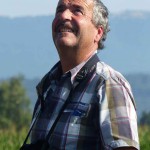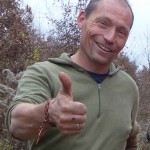
Dr Luc Hoffmann, a great fan of Ospreys and their reintroduction to Switzerland, has sadly passed away on 21 July in his beloved Camargue.
Born January 23, 1923 in Basel on the Rhine River—a river where the last breeding pair of Ospreys had nested in Switzerland in 1914, Luc Hoffmann played an instrumental role in the creation, amongst others, of the WWF (1961), the Ramsar Convention (1971), the Biological Station of the Tour du Valat in the Camargue (1954) and the MAVA Foundation (1994).
Ornithologist and pioneer in protecting wetlands, Luc Hoffmann had a special passion for birds living in these habitats. His vision and commitment have been critical for the preservation of emblematic aquatic ecosystems such as the Camargue in France, the Coto Doñana in Spain and the Banc D’Arguin in Mauritania. Places known worldwide as important breeding, migratory stopover or wintering places for numerous species of waterbirds, including the Osprey.
During the annual flamingo ringing operation in the Camargue in late July 2011, Luc Hoffmann was one of the first people to be consulted about the Swiss Osprey reintroduction project, along with his friend and world flamingo expert Alan Johnson. Both were enthusiastic about the idea, with Alain Johnson calling it a “mind-blowing project”, while Luc Hoffmann noted that it was a “project that needs to be done”.
A member of Nos Oiseaux for many years, Luc Hoffmann was as modest and discreet as he was effectively engaged in countless initiatives, providing a decisive role in their success. When the Osprey starts breeding in Switzerland in a few years’ time, it will be in part due to the passion of Luc Hoffman and the valuable support provided, thanks to him, by the MAVA Foundation.

 Twelve young ospreys coming from former eastern Germany and from southern Norway are now in Switzerland at the reintroduction site of Bellechasse (FR). We will keep them in the specially constructed “hacking” cages until they are ready to fly. Right now they are adapting to their new home and their new environment and, like all growing teenagers, eating a lot!
Twelve young ospreys coming from former eastern Germany and from southern Norway are now in Switzerland at the reintroduction site of Bellechasse (FR). We will keep them in the specially constructed “hacking” cages until they are ready to fly. Right now they are adapting to their new home and their new environment and, like all growing teenagers, eating a lot!
 We could never have done this project without the enormous amount of time and effort that have been provided by a large number of volunteers. We held a little ceremony at the General Assembly of Nos Oiseaux on March 19th in recognition for every volunteer that spent two weeks taking care of our birds on-site at the Bellechasse prison last summer. They all received a certificate thanking them for their personal engagement, as well as a little “low calorie” gift of… hazelnut biscuits. To remind them of how many packets were eaten during the memorable hours spent watching over the birds during the summer of 2015. Once again our thanks to all who have contributed to the project. Note too that it is still not too late to sign up to volunteer for the project for two weeks during the summer of 2016. We look forward to hearing from you on
We could never have done this project without the enormous amount of time and effort that have been provided by a large number of volunteers. We held a little ceremony at the General Assembly of Nos Oiseaux on March 19th in recognition for every volunteer that spent two weeks taking care of our birds on-site at the Bellechasse prison last summer. They all received a certificate thanking them for their personal engagement, as well as a little “low calorie” gift of… hazelnut biscuits. To remind them of how many packets were eaten during the memorable hours spent watching over the birds during the summer of 2015. Once again our thanks to all who have contributed to the project. Note too that it is still not too late to sign up to volunteer for the project for two weeks during the summer of 2016. We look forward to hearing from you on  Ospreys tend to be a little lazy, as they prefer moving into existing nests rather than building their own from scratch. This is why building nest platforms (see our first two built on
Ospreys tend to be a little lazy, as they prefer moving into existing nests rather than building their own from scratch. This is why building nest platforms (see our first two built on 





























 We recently received some shocking news from Algeria concerning one of our young ospreys called PP5 (nicknamed “Chernobyl” due to the markings on the back of his head which resemble a radiation symbol). This male had been found shot by a poacher in the region of the Djurdjura National Park, about 100 km east of the capital city Algiers.
We recently received some shocking news from Algeria concerning one of our young ospreys called PP5 (nicknamed “Chernobyl” due to the markings on the back of his head which resemble a radiation symbol). This male had been found shot by a poacher in the region of the Djurdjura National Park, about 100 km east of the capital city Algiers.
